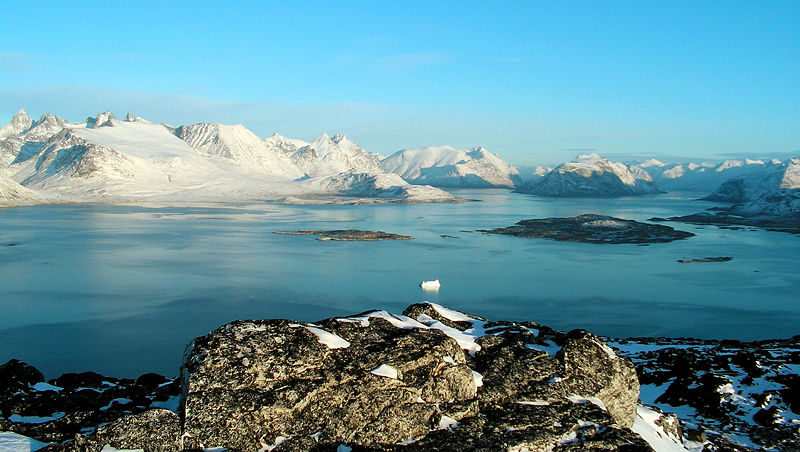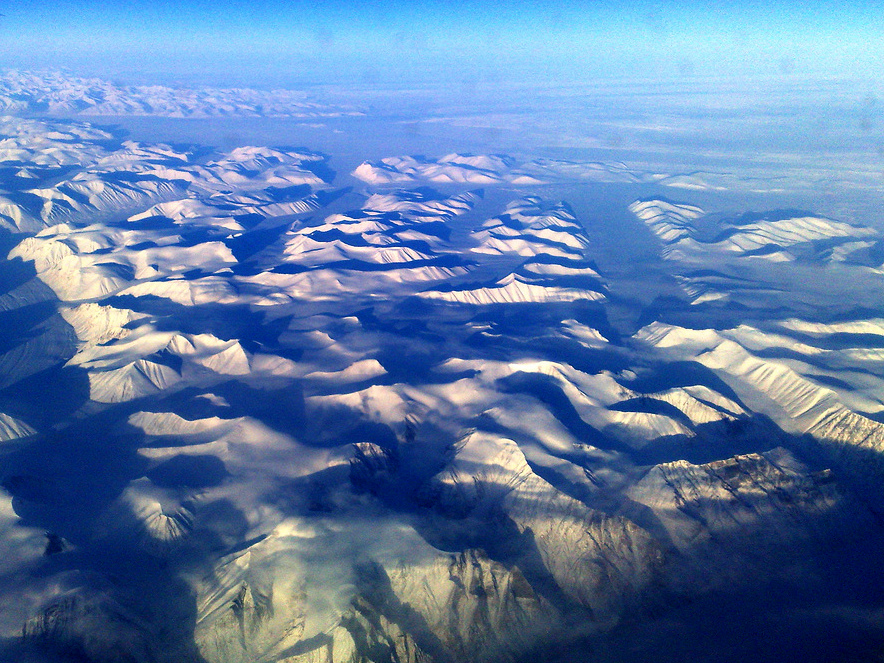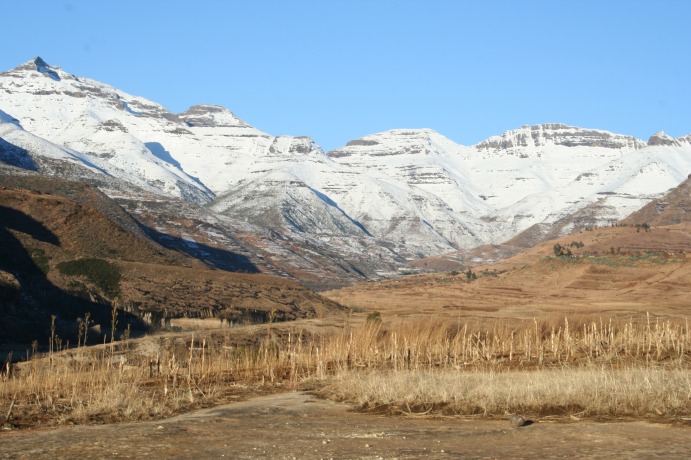Continental Collisons and Carbon Dioxide
Interview with
Kat - Now, you're probably aware that different continents shuffle around. Some slowly colliding while others pull away. And you may also probably know that this the process that leads to the production of mountain ranges and can lead to devastating earthquakes. But you may not have realized that this same process might have been responsible for a global shift in temperature, plunging us into an ice age. Now to find out more, we're joined by Dennis Kent who's over at Rutgers University in the US. So hello, Dennis.
Dennis - Hello.
 Kat - How's things over in the US?
Kat - How's things over in the US?
Dennis - Not too bad, climate wise - weather wise is cold.
Kat - Excellent. Now let's talk about some of these climate changes. Tell us very briefly how the climate has changed over say, the past 100 million years?
Dennis - Well, over the last 100 million years, it started out being very warm and there was a transition about 35 million years ago to development of ice sheets first in Antarctica. And later, more recently, in the last few million years, the ice sheet in Greenland and every now and then during this current ice age, enveloping some parts of Scandinavia, Great Britain, of course, much of North America.
Kat - So, we're actually kind of in an ice age now, technically?
Dennis - Most definitely.
Kat - Definitely as well as technically. Now, looking back again, sort of 100 million years ago, what did the world look like? Were the continents were in the shape that we know them today?
 Dennis - The continents were in quite different places and even prior to 100 million years ago, they were lumped together in what we call Pangaea, a giant landmass that extended virtually from pole to pole. That drifted apart starting about 180 million years ago. Then about 100 million years ago, the continents were quite well dispersed and then started the process from dispersion into collision. And so, the last 100 to 150 million years, the continents were recoalescing in part.
Dennis - The continents were in quite different places and even prior to 100 million years ago, they were lumped together in what we call Pangaea, a giant landmass that extended virtually from pole to pole. That drifted apart starting about 180 million years ago. Then about 100 million years ago, the continents were quite well dispersed and then started the process from dispersion into collision. And so, the last 100 to 150 million years, the continents were recoalescing in part.
Kat - So, we've established that the continents kind of drifted apart and now, they're drifting back together and crunching together. But how is this related to climate change? Surely it's just, continents crushing into each other. How can that affect the climate?
Dennis - Well, the mechanism that we've been thinking about is looking at sources of CO2 and assuming that the long term changes in climate are due to different levels of CO2 in our atmosphere. Some of the main sources of CO2 is ocean spreading ridges and then also, in so-called subduction zones where the ocean floor is being subsumed. Our idea is that the amount of CO2 produced in ocean ridges stays more or less constant at kind of a background level. But the main variation in CO2 production is in subduction zones. And it's in those zones, it's the character of the sediment that enters into them.
Kat - So, one of the areas you've studied is basically where India has kind of crunched into Asia. What do you think is going on there?
 Dennis - Yes. That's a critical area for two reasons. One, it was a place where several thousands of oceanic crust was subducted under Asia as India made its migration from the southern hemisphere to the northern hemisphere. And importantly, the ocean crust that was being subducted had to go under the equatorial belt which was a locus of carbonate production by microorganisms like foraminifera living in the water column. And preferentially, being along the equator, it was warm, there's also some nutrients from upwelling waters. They drop down on to the ocean floor and then were subducted, and it's this decarbonation in the high temperatures and pressures of a subduction zone that release CO2 and that then caused a warmer climate until that factory shut down.
Dennis - Yes. That's a critical area for two reasons. One, it was a place where several thousands of oceanic crust was subducted under Asia as India made its migration from the southern hemisphere to the northern hemisphere. And importantly, the ocean crust that was being subducted had to go under the equatorial belt which was a locus of carbonate production by microorganisms like foraminifera living in the water column. And preferentially, being along the equator, it was warm, there's also some nutrients from upwelling waters. They drop down on to the ocean floor and then were subducted, and it's this decarbonation in the high temperatures and pressures of a subduction zone that release CO2 and that then caused a warmer climate until that factory shut down.
Kat - So the idea is, there is all this little sort of plankton and things on the seabed are then getting squished up in releasing their CO2 into the atmosphere. Would that have really been enough to cause a massive global climate change, sort of the end of the last ice age?
Dennis - Well, actually that was what was sustaining and making the climate warmer. And it was the absence of that, that I think contributed to a shift in CO2 levels in the atmosphere to lower values as it equilibrated with lower amounts of CO2 being injected into it. And so, this was the time at which India collided with Asia of course, is when the factory shut down. That happened 50 million years ago and it's at precisely of this time that the world's climate started to deteriorate.
Kat - And so, is this kind of process still happening today? Is there another region that we think might start releasing lots of CO2 and could again change the climate?
Dennis - Well, eventually but right now, there's very little old carbonate sediment that's being subducted, just under the Central America actually. And so, the amount of CO2 from this source at least has not really increased, nor does it look like there's prospect of it increasing anytime in the near future.
Kat - And what kind of things are you and your group are looking at at the moment? Where do you go next now you've discovered probably this crunching of India into Asia has released CO2? What more are you doing to understand the process?
 Dennis - Well, what led up to it is occupying a little bit of our time because over the cretaceous or this period about 100 million years ago until the factory stops at 50 million years, the cretaceous had climates that were hardly even warmer within the year 50 million years ago, until the crunch. So, we're looking at a more detail at how much carbonate sediment was subducted then. That's when these are coincidences or perhaps some other reasons that the development of microorganisms that live in the water column, they secrete calcium carbonate actually became prolific at about the time that India started moving north. So, it's this kind of unique circumstance that contributed to the very warm climates from the 100 to 50 million-year interval.
Dennis - Well, what led up to it is occupying a little bit of our time because over the cretaceous or this period about 100 million years ago until the factory stops at 50 million years, the cretaceous had climates that were hardly even warmer within the year 50 million years ago, until the crunch. So, we're looking at a more detail at how much carbonate sediment was subducted then. That's when these are coincidences or perhaps some other reasons that the development of microorganisms that live in the water column, they secrete calcium carbonate actually became prolific at about the time that India started moving north. So, it's this kind of unique circumstance that contributed to the very warm climates from the 100 to 50 million-year interval.
Kat - Absolutely fascinating stuff. Well, thank you very much. That's Dennis Kent from Rutgers University in the US, explaining how continental collisions cause a change in the amount of CO2 from the seabed released into the atmosphere. And then when it stops, it leads to the ice age that we are now in.
- Previous Trekking to Everest Base Camp
- Next The 2009 Nobel Science Prizes









Comments
Add a comment